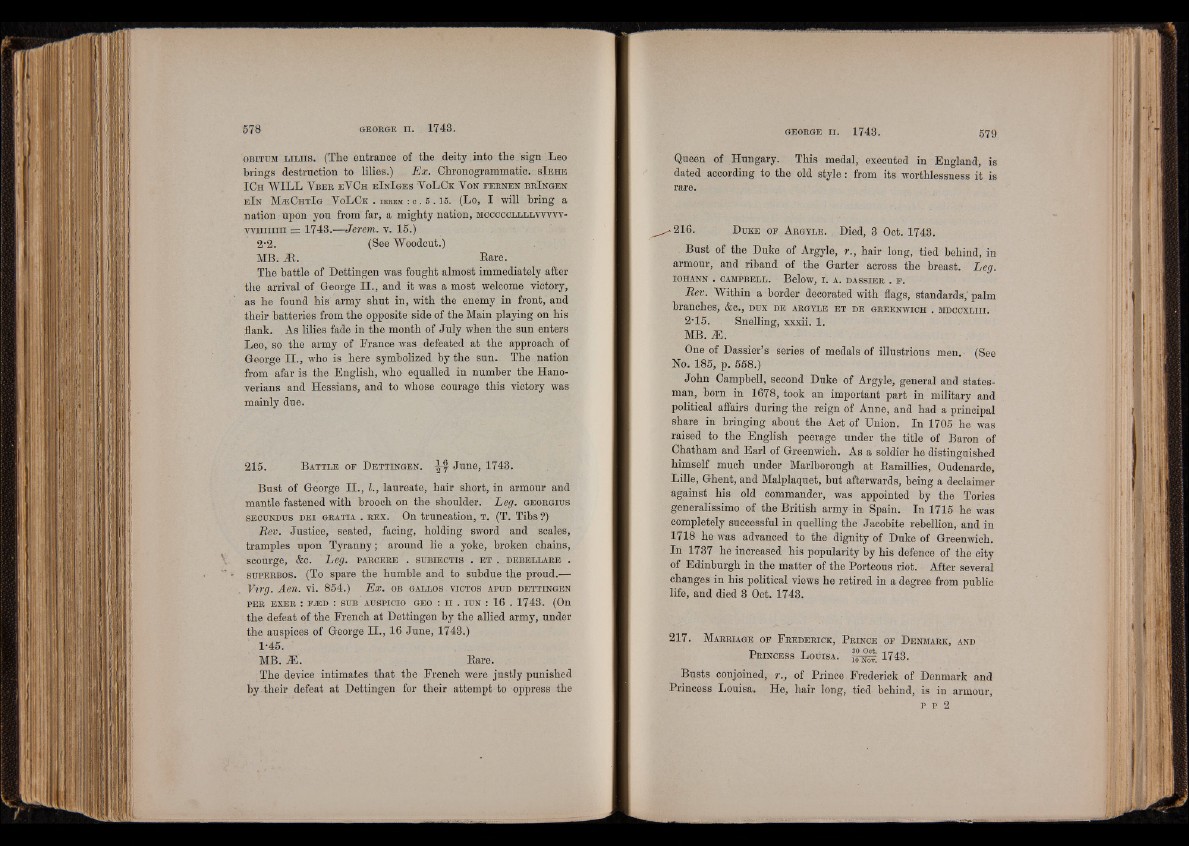
o b i tu m l i l i i s . (The entrance of the deity into the sign Leo
brings destruction to lilies.) Ex. Chronogrammatie. s I e h e
I C h WILL V b e e e Y C h e I n I g e s V o L C k Y o n f e e n e n b e I n g e n
e I n M j e C h t I g Y o L C k . i e r e m : c . 5 .1 5 . (Lo, I will bring a
nation upon you from far, a mighty nation, m c c c c c l l l l v v v v v -
w i i i i i i i i - - 1748.—Jerem. v. 15.)
2'2. (See Woodcut.)
MB. At. Rare.
The battle of Dettingen was fought almost immediately after
the arrival of George II., and it was a most welcome victory,
as he found his army shut in, with the enemy in front, and
their batteries from the opposite side of the Main playing on his
flank. As lilies fade in the month of July when the sun enters
Leo, so the army of France was defeated at the approach of
George II., who is here symbolized by the sun. The nation
from afar is the English, who equalled in number the Hanoverians
and Hessians, and to whose courage this victory was
mainly due.
215. B a t t l e o f D e t t in g e n . June, 1743.
Bust of George H., L, laureate, hair short, in armour and
mantle fastened with brooch on the shoulder. Leg. g e o e g iu s
se c u n d u s d e i GEATiA . e e x . On truncation, t . (T. Tibs ?)
Rev. Justice, seated, facing, holding sword and scales,
tramples upon Tyranny; around lie a yoke, broken chains,
scourge, &c. Leg. p a b c e e e . s u b ie c t is . e t . . .d e b e l l a r e .
s u p e e b o s . (To spare the humble and to subdue the proud.—
Virg. Aen. vi. 854.) Ex. ob g allos v ic to s a p ijd d e t t in g e n
PEE EXEE : FAED : SUB ATJSPICIO g eo : I I . iu n : 16 . 1743. (On
the defeat of the French at Dettingen by the allied army, under
the auspices of George H., 16 June, 1743.)
1-45.
MB. M. Rare.
The device intimates that the French were justly punished
by their defeat at Dettingen for their attempt to oppress the
Queen of Hungary. This medal, executed in England, is
dated according to the old style : from its worthlessness it is
rare.
-216. D u k e o f A e g y l e . Died, 3 Oct. 1743.
Bust of the Duke of Argyle, r., hair long, tied behind, in
armour, and riband of the Garter across the breast. Leg.
IOHANN . CAMPBELL. Below, I . A. DASSIEE . F.
Rev. Within a border decorated with flags, standards,' palm
branches, &c., d u x d e a e g y l e e t d e g e e e n w ic h . m d c c x l ii i.
2-15. Snelling, xxxii. 1.
MB. 2E.
One of Dassier’s series of medals of illustrious men. (See
No. 185, p. 558.)
John Campbell, second Duke of Argyle, general and statesman,
born in 1678, took an important part in military and
political affairs during the reign of Anne, and had a principal
share in bringing about the Act of Union. In 1705 he was
raised to the English peerage under the title of Baron of
Chatham and Earl of Greenwich. As a soldier he distinguished
himself much under Marlborough at Ramillies, Oudenarde,
Lille, Ghent, and Malplaquet, but afterwards, being a declaimer
against his old commander, was appointed by the Tories
generalissimo of the British army in Spain. In 1715 he was
completely successful in quelling the Jacobite rebellion, and in
1718 he was advanced to the dignity of Duke of Greenwich.
In 1737 he increased his popularity by his defence of the city
of Edinburgh in the matter of the Porteous riot. After several
changes in his political views he retired in a degree from public
life, and died 3 Oct. 1743.
217. M a ek ia g e o f F e e d e e ic k , P e in c e o f D enm a ek , and
P e in c e s s L o u isa . 1743.
Busts conjoined, r., of Prince Frederick of Denmark and
Princess Louisa. He, hair long, tied behind, is in armour,
p p 2